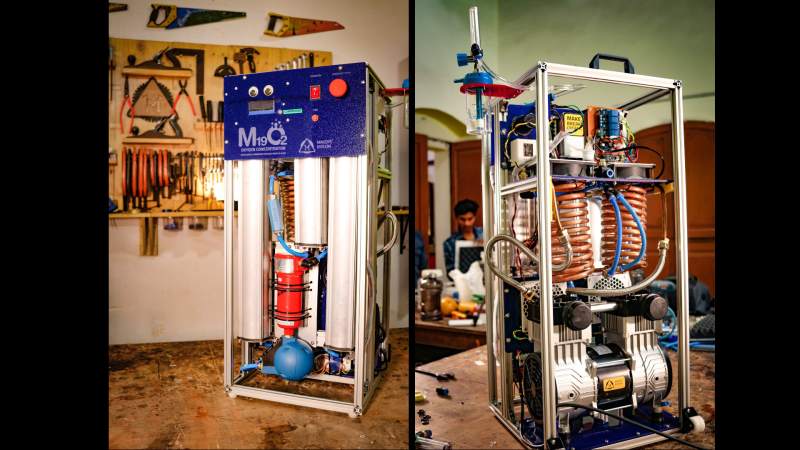A lot of projects we feature on these pages are of the “one and done” variety — tactical builds that serve a specific purpose with little need for further development. Some projects, though, come out as rough prototypes and then go through multiple rounds of refinement, a process we really enjoy tracking down and following. And when the project is something as important as an oxygen concentrator that can be built and maintained easily, all the better.
The need for cheap oxygen concentrators stems directly from the COVID-19 pandemic, which suggested that high-flow oxygen therapy was a better choice than invasive intubations and mechanical ventilation. But medical-grade oxygen isn’t always easy to come by in all parts of the world, so easily built oxygen concentrators, which rely on the nitrogen-adsorbing properties of the mineral zeolite, are meant to fill the gaps. Early versions of the M19O2 and the related OxyKit concentrator, had a very homebrew feel to them, built on wooden frames as they were. And while the rustic nature of the early builds didn’t detract from their utility, the hackers behind them, including our own [Anool Mahidharia], have been making incremental improvements aimed at not only making the devices work better, but also making them easier to build.
The hackers at Maker’s Asylum have done a fantastic job at documenting their work, with everything posted to a GitHub repo so that anyone can undertake a build. And really, for something as important as making oxygen when it’s needed, there’s really no reason not to give this a try.
















I heard all you need is a paper mask to separate oxygen from the atmosphere.
Gonna go run out and patent that right now.
/s
Amazing project, nice.
Interesting post, coincidence to a degree as I posted a question on separation membranes here last 2 days :-
https://www.quora.com/What-are-existing-commercially-available-gas-separation-membranes-for-air-such-as-to-extract-argon-or-nitrogen-versus-oxygen-near-room-temperature-without-needing-to-chill-down-to-liquid-air-temperatures
I understand oxygen permeates out of car tyres slightly faster than nitrogen, so some sort of size targetted semipermeable membrane should be possible and potentially less onerous to maintain than zeolites.
Thanks for posting :-)
Look into these (PDF):
https://www.parker.com/Literature/Hiross%20Zander%20Division/PDF%20Files/PIS/K3.1.333_Technology_overview_membrane_modules_for_nitrogen_and_oxygen_systems_EN.pdf
I use them in a process in our lab to provide a continuous ~99.5% pure N2 supply. The “waste” is everything else (O2 argon etc). I have not looked into the O2 purity side of things but I am sure that side could be optimized using different membranes and/or different pressure and flow rates.
This method may be more expensive for O2 production as the compressed air requirements are pretty high compared to what is required for the O2 generator in the article
Having just today got out of a COVID pneumonia hospital ward, I have a very high appreciation for oxygen concentration technology. For the first couple of days I was on 5 liters per minute of oxygen. Fortunately I had a fast recovery and was able to be tapered off over a few days to needing no supplemental oxygen up my nose.
Hmmm, thant was meant as a reply to Mike Massen, Perth, Western Australia
Brilliant thanks 3DGuy :-)
Fascinating, especially as it states water comes out along with oxygen whilst nitrogen doesn’t in that it accumulates at the “retentate”, a bit weird suggesting a Quantum Mechanical effect eg as water a larger and less symmetrical dipole than N2 yet O2 smaller than N2 despite O2 higher in mass than N2, hmm. Only skimmed it at mo as much on, heck 5:30am here ASX math to do.. Curious your application (if more exotic than just getting O2) and experience eg have you noticed if D2O vs H2O not as permeated, life of membrane, robustness, temperature issues, degradation etc Sorry for lots of queries, I see diverse potential for these types of materials & potentially pointers to extending paradigm…
I have an interesting out there lab experiment in craft mode soon which would could use layers of flat materials of that type along with collecting data on variety of attributes in a solute since it has that odd issue re water, as I say still going through that brochure, thanks again, more L8ter, cheers
No worries.
I use the N2 side it to create an inert atmosphere for an SLS 3D printer. As far as I understand it, it is a molecular sieve, allowing everything but the N2 out as it has the largest kinetic diameter. As such, the N2 purity is inversely proportional to flow rate – slowing everything down allows more time for the O2, H2O etc to escape. I assume (but have never tested) that the inverse is true for the O2 side. For the N2 side, it does not matter if this process is a bit leaky and you end up with N2 in the waste gas side – just that you get as little O2 as possible in the N2 side.
The “waste” vents to the room and I have no use for it. I do have to monitor the O2 concentration in the room though to make sure that it does not build up to dangerous concentrations.
The whole setup is a bit involved as the membranes themselves are quite expensive (~$15k + depending on flow rates) and are also quite vulnerable to oil in the air stream so you need to do a lot of filtering of the air out of the compressor to protect it (dryer, filters and then an activated carbon filter). The whole setup, excluding the compressor, is around $ 20k-25k. Once set up though it is very low maintenance.
(Hopefully this comes out as a reply…)
People who do art glass and some metal jewelry work love old but functional oxygen concentrators. They just need a natural gas supply to tap into and have a small, hot flame to work with.